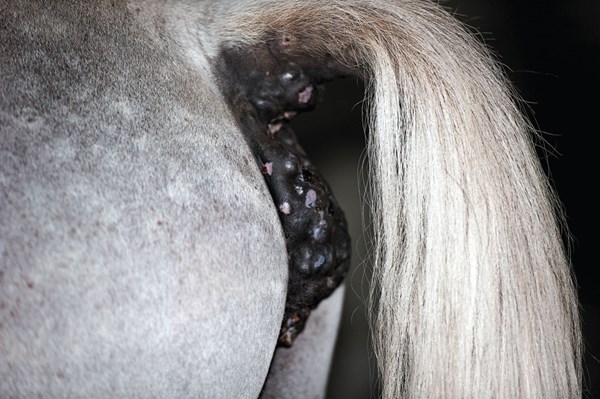 Melanoma tumors can appear as firm, dark lumps under the tail. | © Paula da Silva/arnd.nl
Melanoma tumors can appear as firm, dark lumps under the tail. | © Paula da Silva/arnd.nlResearchers are exploring a new approach to treating melanomas in horses—therapeutic vaccination. The goal is to harness the horse’s immune system to fight these skin tumors.
In melanomas, cells that contain the dark pigment melanin (called melanocytes) proliferate. The tumors develop in most gray horses as they age and are usually less dangerous in horses than they are in humans. They typically appear as firm, dark lumps in the skin, under the tail and on the dock or sometimes around the eyes or mouth or in other areas. In most cases, the tumors grow slowly, if at all. But sometimes one will suddenly begin to grow quickly, and a large one can interfere with defecation or cause other problems. Surgery and other treatments have mixed results. Aggressive melanomas can invade neighboring tissue and spread through the body, in which case not much can be done.
Therapeutic vaccination could be another tool for fighting the tumors. Just as the preventive vaccines you give your horse prime the immune system to attack disease-causing viruses and bacteria, a therapeutic vaccine would stimulate an immune response to cancerous cells. One vaccine being studied is based on a canine melanoma vaccine (Oncept, from Merial). With Morris Animal Foundation funding, a team led by Jeffrey Phillips, DVM, of Lincoln Memorial University, evaluated its use in horses. This vaccine trains the immune system to target a protein, tyrosinase, that is concentrated in melanoma cells.
The horse’s immune system doesn’t normally attack tyrosinase because the protein isn’t foreign—it’s also present in normal melanocytes. But the vaccine delivers the genetic code for human tyrosinase inserted in a small ring of DNA. When the horse’s immune system spots the human protein, it mounts a response, churning out immune cells primed to attack it. The attack then carries over to the melanoma cells.
Tumors shrank in most of the horses treated in Dr. Phillips’ study, and there were no harmful reactions. Larger trials are underway with an eye to having the vaccine licensed for use in horses. Right now it can only be used off-label, and it’s expensive—in the range of $2,500 for a series of four shots, followed by a six-month booster.
—Elaine Pascoe
This article originally appeared in the May 2016 issue of Practical Horseman.
Save





